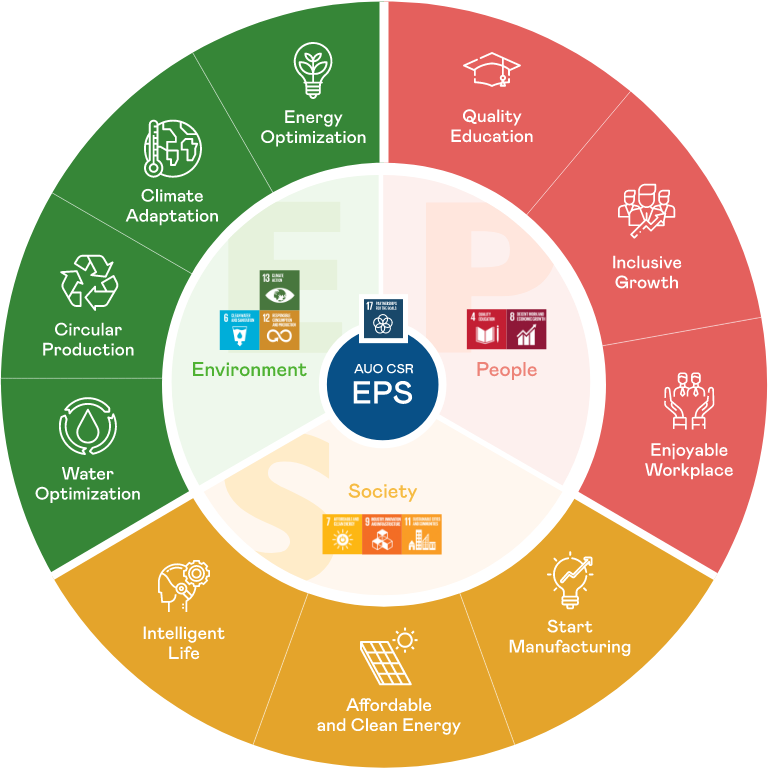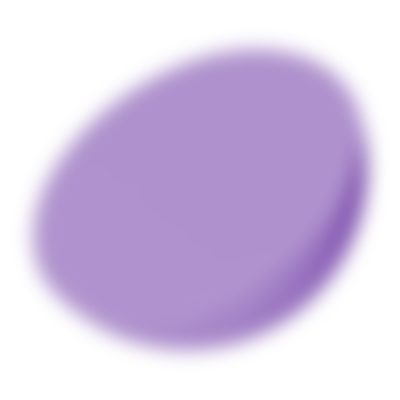Strategy and Goals
AUO hopes to work with stakeholders through its core technologies to build a partnership for mutual growth and sharing between the enterprise and society.
The 17 Sustainable Development Goals (SDGs) developed by the United Nations was used by AUO to define a corporate sustainability roadmap of "Go Beyond CSR, Create Shared Values." The three EPS (Environment, People and Society) themes focusing on environmental sustainability, inclusive growth and agile innovation were defined in response to increasing awareness of environmental issues and social inclusion trends.
The EPS sustainability themes are expanded into 10 concrete directions aspects. AUO is committed to realizing the short, medium and long-term targets for sustainable development by 2025. Close attention is paid to environmental issues such as climate change and consumption of Earth's resources. Helping disadvantaged groups and improving quality education have long received AUO's support as well. New future opportunities in energy and intelligent applications are now being welcomed through agile innovation.



Scopes
EnvironmentEnvironment
Inclusive GrowthPeople
Agile InnovationSociety
SDGs

Categories
- Quality Education
- Enjoyable Workplace
- Affordable and Clean Energy
- Water Optimization
- Climate Adaptation
- Inclusive Growth
- Smart Manufacturing
- Intelligent Life
- Circular Production
- Energy Optimization

Environment
Energy Optimization

Environment
Water Optimization

Environment
Circular Production

Environment
Climate Adaptation

People
Quality Education

People
Inclusive Growth

People
Enjoyable Workplace

Agile Innovation
Affordable and Clean Energy

Agile Innovation
Smart Manufacturing

Agile Innovation
Intelligent Life
Optimize product life-cycle and energy consumption through technology and management; work with value chain partners to create even greater environmental benefits.
Optimize product life-cycle and water resources through technology and management; work with value chain partners to create even greater environmental benefits.
Reduce the environmental impact of the production process; take circular economy value and extended applications into account.
Reduce the risk to company operations from the climate and Improve adaptability to build a resilient value chain.
Improve employee competency, promote industry-academic collaboration, popularize basic education and provide disadvantaged students with equal access to education.
Support employment for youths and the disadvantage, and include them in the value chain to promote national economic growth.
Build a quality working environment that helps employee balance work and family; invite value chain partners to participate as well.
Popularize renewable energy to make it more affordable and easy to use; increase market share in Taiwan and become a professional global provider of renewable energy.
Improve manufacturing competitiveness through intelligent management; play a key role in technology (IIoT) and services to help with the transformation of other industries.
Combine industry advantages with AI technology to create smart living and smart cities.
Set reduction targets based on life-cycle and reduce carbon emissions by up to 6.5 million tones CO2e cumulatively.
Work with the value chain to combat the threat of water resource shortages and conserve up to 100,000 CMD in tap water cumulatively.
Spearhead the development of the circular value chain, expand its economic performance and achieve a growth rate of 135%.
Increase the resilience of climate adaptation and continue to reduce the risk of financial impact from climate change issues.
Provide diversified educational opportunities to more than 600,000 people and increase employee participation in AUO quality education by 20% each year.
Support the disadvantaged and ally with industry chain partners to grow inclusive employment and learning opportunities more than eight-fold.
Become the preferred enterprise and reach 80% in employee identification with the four dimensions in Primary demand, Management support, Team work and Learning and growth.
Improve capability in renewable technology, expand the installed capacity of renewable energy around the world and double the cumulative growth rate. (100% cumulative growth)
Boost industry competitiveness and overall performance by 50% through intelligent manufacturing and technology integration.
Development products and integrated services to expand the cumulative reach of education, health, finance, shopping, lifestyle, transport and other smart city applications to a one billion people.












































over 100 %

over 100 %

84 %

Continue to manage risk

85 %

98 %

Achieved for 3 consecutive years

89 %

84 %

95 %













